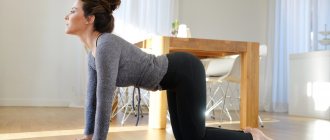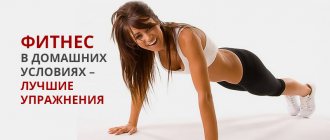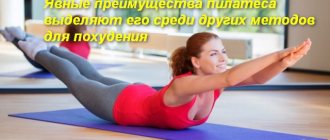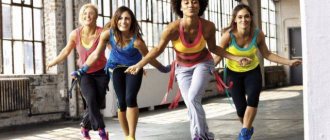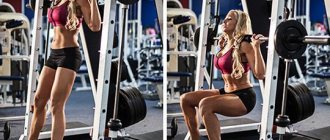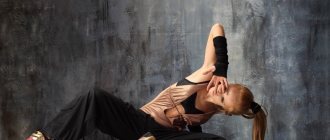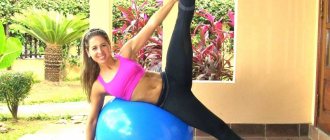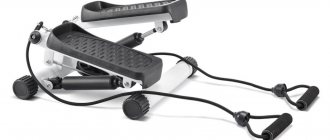In fitness centers, you can increasingly see people working out on large rubber balls.
If in childhood it was associated with a fun pastime, now it is used for health purposes. This ball is called a fitball, and it is an effective exercise machine for strengthening the musculoskeletal system and for losing weight.
Benefits of classes
Initially, fitball was intended for training with people suffering from cerebral palsy. But the results were so impressive that it began to be used when working with patients with spinal injuries. Gradually, exercises on a fitball became more and more popular, thanks to the benefits that exercises with it brought.
The benefits of classes are as follows:
- During exercise, you have to use more muscles to maintain balance. Due to this, a large number of calories are burned.
- By exercising on a fitball, you will strengthen the muscles of your abs, back, lumbar region and buttocks. The advantage is that the muscles that are “resting” during standard training begin to work.
- Exercises on a fitball are safe for the corset muscles of the back and lumbar region.
- Exercises on a rubber ball correct posture and relieve fatigue in the back muscles.
- Coordination improves, muscle elasticity and joint mobility increase.
- Due to the low load on the joints and spine, the risk of injury during such activities is minimal.
- Fitball is recommended for use during rehabilitation exercises for people with injuries of the spine and musculoskeletal system.
- People with varicose veins , ankle injuries and other leg-related injuries are also allowed to exercise on a fitball.
- Fitball is also suitable for pregnant women who want to maintain body elasticity.
- Exercises on a rubber ball have a beneficial effect on the nervous system.
- During training, you simultaneously need to coordinate the work of the motor and vestibular systems.
Exercises on a fitball are recommended not only for women who are losing weight, but also for those who want to maintain the normal functioning of the musculoskeletal system, relax the back muscles and add variety to their exercises.
Features of training
Fitball aerobics is a gentle type of activity in which the risk of injury is minimal. Its distinctive feature is that there is practically no load on the legs. Thanks to this, people of any age and with injured lower limbs can exercise on a fitball.
Thanks to instability, not only does overall coordination improve, but more muscles are used than during simple training. The simplicity of such activities allows you to do them yourself at home. The main thing is to choose the ball correctly.
How to choose a fitball?
To make your training as effective and enjoyable as possible, you need to choose the right ball.
Pay attention to the following parameters:
- the fitball must be made of ice-plastic, latex or PVC;
- there should be no protruding seams on the product;
- the ball should be warm to the touch, and when pressed by the palm it should bounce;
- a good fitball has a smooth surface and antistatic properties;
- It is important to have the following inscriptions: ABS, BRQ or “Anti-burst system”. This ensures that your ball is protected from unexpected breaks;
- Be sure to look at the maximum weight the product can support. Most often, restrictions start from 100 kg and more. This is especially important for those who plan to exercise on it with weights;
- A pleasant bonus will be the presence of a pump in the kit. If you have one (for example, from a bicycle), then there is nothing to worry about.
You need to choose the right ball with the right diameter. They come in a variety of sizes, but the most popular are 65 and 75cm. To ensure that you have selected the correct diameter, perform the following test. You need to sit on the fitball and look at the angle that is formed between the lower leg and thighs. It should be 90-100º.
Varieties of fitball
There are several types of gymnastic balls. Everyone will be able to choose the most suitable option.
They are:
- round;
- oval;
- balance steps.
Balance step
Oval
The main difference is the different level of sustainability . Thus, classic fitballs (round) have minimal fixation, due to which more muscle groups are involved. In other varieties, the fixation is more confident, which allows you to perform complex exercises.
There are also gymnastic balls:
- with a smooth surface;
- massage ball (with spikes) – recommended for use by people with diseases of the nervous system or disorders of the musculoskeletal system;
- a ball with horns or handles is ideal for children.
Basic exercises for the buttocks on a fitball
Fitball is considered one of the least dangerous equipment, but it is still recommended to start classes with the simplest exercises. Fitness club trainers are often asked if it is possible to pump up your butt by jumping on a fitball. The answer is usually: no, but you'll have fun. Do the exercise correctly. Sit on the ball, keep your back straight, and press your feet firmly to the floor. Proceed to jumping without lifting your feet from the floor and the remaining fulcrum from the ball. Try to make jumps rhythmic, as fast and energy-consuming as possible. Don't forget to tighten your gluteal muscles. The exercise lasts 5–7 minutes, but this is individual, as is the number of approaches.
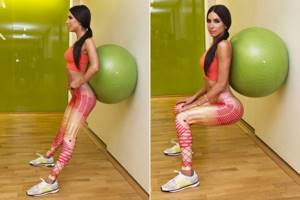
The plank on a fitball is quite effective for the back, abs and buttocks. Kneel next to the apparatus, rest your elbows and forearms on the ball, straighten your knees and take a plank position. The retention time can be gradually increased from a few seconds to a minute. The number of repetitions from 5 to 10 should also be increased gradually as training progresses. If you persistently look for a way to pump up your butt on a ball, then in the future the exercise can be complicated by alternately moving your legs back. Even if this does not bring you closer to your goal, at least at first it will give you a little pleasant adrenaline, and in the end it will increase your sense of balance.
A set of exercises for various muscle groups
You should exercise 2 hours after eating. The room should be ventilated, and the surface for practicing should be smooth and non-slip. Any workout begins with a warm-up.
Warm-up
It is done to warm up the muscles in order to minimize the risk of injury, and the result of the workout is more effective.
Warm-up exercises:
- Extend your arms forward with the ball. Hold the exercise ball and perform 30 side steps in both directions.
- Jog lightly for one minute.
- Holding the ball in your hands, walk in place, lifting it with outstretched arms, then lower it to your waist.
- Holding the exercise ball in front of you, perform 10-12 squats.
- I. p. – sitting on the ball, place your feet shoulder-width apart. Watch your posture, your stomach should be pulled in. Maintaining this position, bounce on the ball for about 2 minutes. At the very beginning, you can lean your hands on the ball until you can maintain your balance. Then perform circular movements with your arms (10 times in both directions).
- I.p. – sitting on the ball, try to place your legs as wide as possible, resting on your toes. Spring on the ball, then jump, bringing your legs together and returning them to the jump. At the same time, bring your arms together in front of your chest, without bending your elbows, and move them back as far as possible.
- I.p. - sitting on a fitball. Imitation of running in place, raising your knees high.
Back exercises
Stretching (relaxing) the back muscles
It is aimed at training the deep muscles of the lumbar region. This makes it possible to stretch the muscles located in the shoulder and thoracic spinal regions. This exercise allows you to develop back flexibility. It's better to start with 5-7 approaches.
Exercise:
- I.p. – lying on your stomach on a fitball, legs stretched out, pressing your toes into the floor, not forgetting about balance.
- Your arms should be parallel to your body. Slowly lift your upper body. Particular attention should be paid to the back muscles. Pause at the highest point. Hold this position for a few seconds and return to the rep position.
- You can make the exercise more difficult. Squeeze your shoulder blades together - this will put stress on the muscles of the upper back.
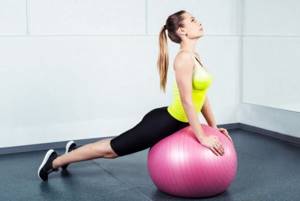
This exercise helps stretch the muscles, distributes the load evenly across the joints, and improves the functioning of the vestibular apparatus.
Important! If you feel pain in your back, stop doing the exercise immediately!
Exercise to help you lose weight on your back
It is aimed at alternating periods of tension and relaxation of the muscles in the lumbar region and relieves spasm. Additionally, the muscles responsible for coordinating body parts work. Due to this, the exercise helps to lose weight on the back.
It is recommended to perform 3 sets of 10 repetitions.
Exercise:
- I.p. – lying on the fitball on your stomach, the body should be relaxed. Place your hands behind your head or in front of you.
- Start raising your body - your back and legs should become one line. No need to try to make a strong deflection! Focus on the sensations in your lower back.
- Hold this position for a few seconds and gradually return to the i.p.

Beginners can do fewer approaches, focusing on maintaining balance.
Crunches
The exercise is aimed at working the abdominal muscles and stretching the spine. It helps burn fat from the sides and lower back.
Exercise:
- I.p. – lie on the ball with your shoulder blades. Bend your legs at a 90º angle or place them on the floor and place your hands behind your head.
- Raise and lower your upper body as if you were doing abs on the floor.
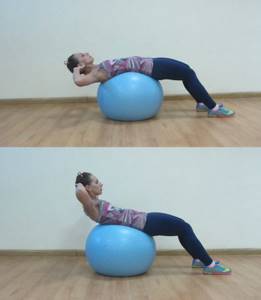
The recommended number of repetitions is from 3 to 15. The load should be increased gradually.
Bridge
It is similar to the classic version, but less traumatic. The number of repetitions is from 1 to 3, which must be increased by 1.
Exercise:
- I.p. – lie on your back so that your calves are on the ball. Place your hands on the floor.
- Roll the fitball, lifting your pelvis off the floor. The ball should be located in the middle of your back. It turns out to be a bridge.
- Stay in this position for a while.
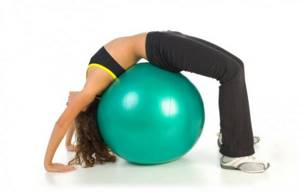
Important! This exercise is not recommended for beginners.
It is aimed at strengthening the muscles of the upper back, lower back and abdomen, forming a muscle corset.
Exercises for the abs
Raising the upper body
This exercise targets the upper abdominal muscles.
Exercise:
- I.p. - sitting on a fitball. Start walking forward, slowly moving the ball under your lower back. The body should be level, the head, back and hips should be at the same level. Hands should be behind the head.
- Tightening your abdominal muscles, exhale, slowly raising your upper body so that your back resembles an arch.
- Slowly return to i.p.
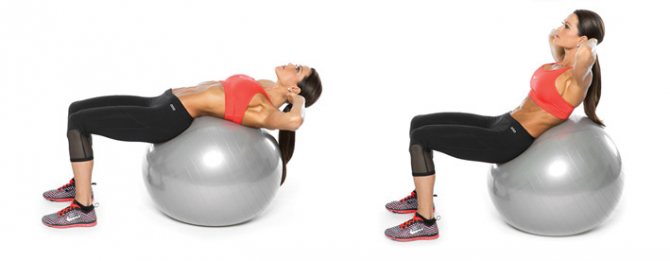
It is recommended to do 2 sets of 20 times.
Crunches
The exercise is aimed at training the oblique abdominal muscles and allows you to remove fat folds on the sides.
Exercise:
- I.p. - as in the previous exercise.
- Rest your right hand on the ball and place your left hand behind your head.
- Perform crunches - try to reach each other with your left elbow and right knee. Do the same in the other direction.
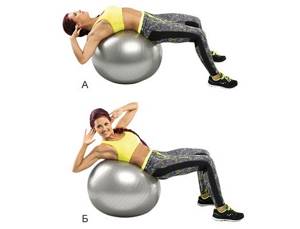
Do 2 sets of 20 reps.
Lifting the ball
The exercise uses not only the abdominal muscles, but also the lower back.
Exercise:
- I.p. – lying on your back with your legs raised straight and the ball placed between your ankles.
- Your thighs should be perpendicular to the floor. Perform flexion-extension of your legs at the knees while holding the ball.

Perform 2 sets of 10 times.
Exercises for losing weight on thighs and buttocks
Wall Squats
For greater efficiency, you can use dumbbells.
Exercises:
- I.p. - standing against the wall. Place the ball between the wall and your lower back. Place your feet slightly forward, shoulder width apart.
- While pressing the ball, perform a squat until your thighs are parallel to the floor. The angle should be 90º, your back should be kept straight, all support should be on the ball.
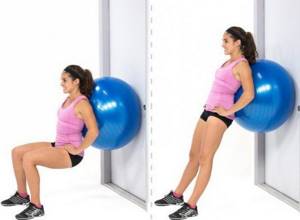
The exercise is performed at a calm pace. Perform 3 sets of 10 reps.
Bridge
This exercise is different from the “Bridge” described above.
Exercise:
- I.p. – lying on your back, resting your heels on the ball.
- Raise your pelvis high without lifting your shoulder blades off the floor, while simultaneously squeezing your gluteal muscles. Then return to IP.
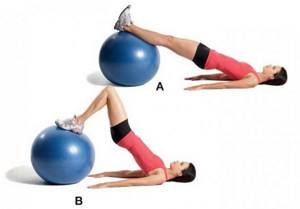
Perform the task 20 times, keeping your knees bent together. Then another 20 times, moving them in different directions while lifting.
Raising a fitball with your feet
This exercise trains the muscles of the inner thigh.
Exercise:
- I.p. – lying on your side, squeeze the ball with your feet.
- Raise your legs straight while holding the exercise ball. Do it on both sides.
Important! Make sure that your legs do not bend at the knees. At the beginning of training, you do not need to try to raise your legs as high as possible.
What muscles are involved?
Let's talk about the buttocks. The gluteal muscles of our body consist of three parts:
- Large ones - located on the back surface of the pelvis and are responsible for convexity and relief;
- The middle ones are located on the sides of the pelvis and are responsible for the beautiful line of the hips;
- Small - attached next to the middle muscles and perform the same functions.
By training each of them, doing exercises for the buttocks on a fitball, you will help your butt become convex, toned and elastic.
It is important to understand that training on a fitball is not isolating.
This means that in addition to the glutes, many other muscles will be involved.
Below are the most effective exercises with a fitball for the buttocks, thighs, abs and lower back muscles. Note!
The size of the fitball that suits you can be calculated as your height – 100 centimeters. Having chosen the one you need, sit down on it, pressing your feet to the floor. Your thighs should be parallel to the flat surface and your knees should be at an angle of 90 degrees.
